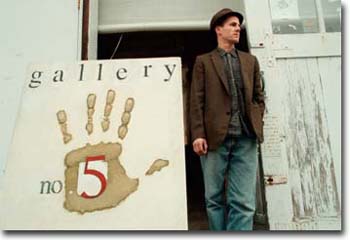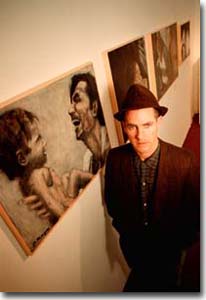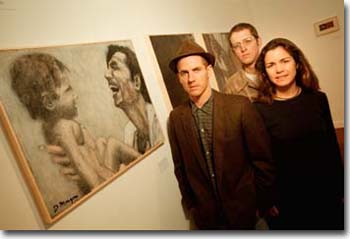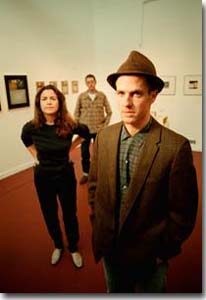![[MetroActive Arts]](/gifs/art468.gif)
[ Arts Index | Metro Santa Cruz | MetroActive Central | Archives ]
Five Alive
A new artists cooperative, Gallery No. 5, makes five a magic number for original, affordable creations
By Mary Spicuzza
AS MARTY McCUTCHEON, one of Gallery No. 5's founders and directors, leads me through one of the Old Sash Mill's barnlike doors to meet the other gallery folk, he rattles off what's left to do before the opening reception for the gallery's latest show. Setting up the lights and arranging pieces top the list--as does finishing the gallery's paint job.
Inside the warehouse, a lone painting hangs on the walls, surrounded by bare wooden stands and busy gallery directors Dylan Morgan, Jay Long and David Johnson. An empty plate covered in brownie crumbs lies next to a six-pack of beer. Paint fumes fill the air, and the still-wet floor glistens an earthy shade of brick red.
A contagious excitement buzzes throughout the group, who are old friends as well as collaborators in Santa Cruz's newest gallery, as they recount their game plan for the next 24 hours.
"How late are you guys going to be here?" I ask incredulously.
A brief period of silence follows as they glance at each other, then at the wet floor. Everyone quickly agrees to call it a night.
At the reception less than 48 hours later, the interior of Gallery No. 5 has been completely transformed. Beams of light pour down from the gallery's classic wood-framed windows, igniting its angled ceiling and white walls with an ethereal glow. The once-vacant wooden columns cast crisp shadows on the perfectly painted--and now dry--floor. Sleek martini glasses stand next to colorful glass jewelry on one column. Nearby, handmade metal earrings dangle alongside intricate necklaces and rings. Wooden boxes, propped open invitingly, anchor the exhibit at the corners of the gallery.
As daunting as the workload seemed a few nights before, the present look of the gallery is simple perfection.
STANDING over one of his creations, furniture maker and gallery director David Johnson explains his love for the functional beauty of wood. Instead of carving and painting his medium, Johnson opts for simple designs that highlight natural patterns found in the grains.
Johnson speaks proudly of his studies with mentor James Krenov, a master craftsman at the College of the Redwoods in Fort Bragg, Calif. Krenov teaches an intensive woodworking program, respected as one of the best this side of the Atlantic Ocean.
Shunning the white-and-pink-painted nursery room approach to furniture making, Johnson continues Krenov's tradition of no-frills form guided by function.
"Nothing makes me happier than seeing people actually using my work," Johnson says.
Although Johnson may be the only furniture maker in the current exhibit, his devotion to detail and his basic love of creating new works are shared by all of the Gallery No. 5 directors.
At Gallery No. 5, the founders aren't art dealers guided by dollar signs, but Santa Cruz-based artists committed to creating a venue highlighting local work. Founders include McCutcheon, who often abandons the standard tools like brushes and paints, using his fingers or rags instead; Dylan Morgan, an oil painter devoted to illuminating the lives of the marginalized; painter and illustrator Jay Long; and Johnson.
In the six months since the venue opened its doors, more than 10 local artists have shown their work in Gallery No. 5. The list of co-op directors also continues to grow; printmaker Stacy Frank, for instance, now masterminds the gallery's mailing list.
Despite their various mediums and different approaches to running a gallery, these artists have come together and managed to provide a forum for fine art that is both original and affordable--and supports local artists. "It's difficult to be an artist in Santa Cruz and support yourself," Johnson says. "The gallery is really a money-losing proposition. ... We just felt it needed to exist."
Leaps of Faith
AFTER maneuvering through a crowded coffee shop, McCutcheon settles into his corner seat next to Dylan Morgan and Stacy Frank. Some might expect that a group of artists gathered together would only talk about lofty philosophical dilemmas--being tortured by humanity or, at the very least, obscure foreign films.
But our conversation quickly leaps to a discussion about raw buffalo meat.
The reserved McCutcheon, an oil painter who works as a poster framer for Paper Vision by day, recounts his experience of eating thinly sliced raw buffalo meat at a tiny restaurant in San Francisco. Conceding that some may view eating raw meat in an unfamiliar place insane, he likens it to a leap of faith.
"It's just that sort of thinking which made Marty want to start a gallery," Morgan laughs.
Just after McCutcheon discovered the other red meat, he was helping his friend Annamalai Nagaraj, a director for UCSC mascot-inspired Slugwear Oxford West, clean out the company's warehouse when Nagaraj mentioned plans to sublet the space.
McCutcheon quickly became a man with a mission. According to the Gallery No. 5 directors, local artists had talked of starting a cooperative for years. But until then, no one except Mission Street's Santa Cruz Pottery had successfully made it happen.
"I knew I couldn't do it myself," McCutcheon says. "I went around talking to different people that seemed like they would be capable of pulling it off."
Six weeks later, in late May 1998, Gallery No. 5 opened its first exhibit. Like most at the gallery, the show featured a collection of works created by gallery directors and other local artists.
McCutcheon's oil paintings often incorporate blocks of hard board--side benefits of his job as a poster framer--into a collage of photographs, rich colors and shapes. His skill at bringing different elements together apparently extends to working with artists as well.
Gallery No. 5 has held receptions for new exhibits just about every month. As new artists become involved, the shows are expanding to include glasswork, photography, sculpture and metal work. Besides providing exhibits featuring a diversity of mediums, the cooperative approach has also put control back in the hands of the artists. Those creating the work decide how it will be displayed, and they don't have to mold their work around what appeals to gallery owners, who often feel pressured to accept only "what sells."
"We want a place where the artists call the shots. Who knows art better than the artists?" Morgan asks. "We're responsible for the co-op and run it with a certain integrity. And we don't have to kiss ass to pay the rent. If I wanted to sell out, I'd go sell insurance."
The intense Morgan, a painter and musician, seems as likely to become an insurance salesman as to become a mall rat hocking pop-culture paraphernalia. His strong aversion to Hello Kitty-inspired pop art has earned him the title of Gallery No. 5's gimmick filter.
"We're not about gimmicky art. The gallery is about sincere, affordable fine art," Morgan asserts. "And crafts that are more artistic than crafty."
Despite his firm notions about artistic integrity, there is nothing pretentious about Morgan's artwork. Most of his oil paintings, often inspired by black-and-white documentary photography, depict the lives of the downtrodden or underrepresented.
"Photographers are talking about real issues that the painters are not talking about," Morgan says emphatically.
In the latest exhibit, Morgan's thick brush strokes and rich colors bring a new depth of emotion to images ranging from everyday working folks to an Indian man and child. Rather than view decoration as a privilege of the rich, the Gallery No. 5 crew sees it as a basic human right.
McCutcheon says that while looking at a book of Dorothea Lange photographs recently he was struck by photographs of migrant workers who, however limited their resources, found a way to decorate their surroundings. "There's just this sublime sense that however little you have, you decorate somehow ... if you're fortunate enough to have walls," McCutcheon says. "Little things become precious objects."
Perhaps it's a healthy respect for working people that has kept Gallery No. 5's directors focused on providing art that doesn't require a trust fund in order to be affordable. At the gallery, handmade glassware, woodwork and jewelry cost much less than the mass-produced mall alternatives. Some paintings cost as little as $150. And everything is made by local artists.
Despite this group's commitment to affordable, locally made art, the gallery directors report stiff competition--not from other artists living in Santa Cruz but from those who are six feet under. Apparently most folks think decorating and automatically opt for a poster of Van Gogh's Starry Night.
"Do you want a Gustav Klimt poster or do you want to explore something on your own, for God's sake," Morgan asks incredulously. "I mean, we're hip to those guys and gals. I love the dead artists. ... But what about the living artists?"
AS the gallery directors weave through topics ranging from starving artists to dead painters, nothing sums up their humble mission better than soft-spoken McCutcheon's philosophy of brown. This philosophy is based on his belief that the world is generally an indifferent place that, for the most part, just does what it does.
"It's not inherently ugly, it's just neutral. Like brown is neutral," McCutcheon explains. "If I take all of my paints and blend them together, it ends up being brown. Then you draw out colors by using more pure versions of them. There is no real, pure color."
"The world's had troubles forever, but good things come out of the attempt to make trouble more harmonious," McCutcheon adds.
Like the color brown, the gallery is made up of artists who've come together. They then use the venue to draw out and highlight their individuality.
"All the colors go back to the oneness. Is that some kind of Zen Buddhist sort of thing?" Morgan laughs. "I don't know. I think I'm absorbing a lot of paint through my fingers."
[ Santa Cruz | MetroActive Central | Archives ]
Copyright © Metro Publishing Inc. Maintained by Boulevards New Media.
![]()

A Show of Hands: Painter Marty McCutcheon, one of the directors of Gallery No. 5, opens doors of opportunity for local artists with a new cooperative approach.
 Picture Perfect
Picture Perfect

What Art Is: Marty McCutcheon (left), David Johnson and Stacy Frank work to keep a focus on art with integrity.
 Philosophy of Brown
Philosophy of Brown
The 1999 Winter Exhibition features works by Dylan Morgan, Stacy Frank, David Johnson, Marty McCutcheon and Keiran Best, and runs through the end of January. Gallery No. 5 is open by appointment at Old Sash Mill Number Five, 303 Potrero St., Santa Cruz. (831.458.3769).
From the January 14-20, 1999 issue of Metro Santa Cruz.